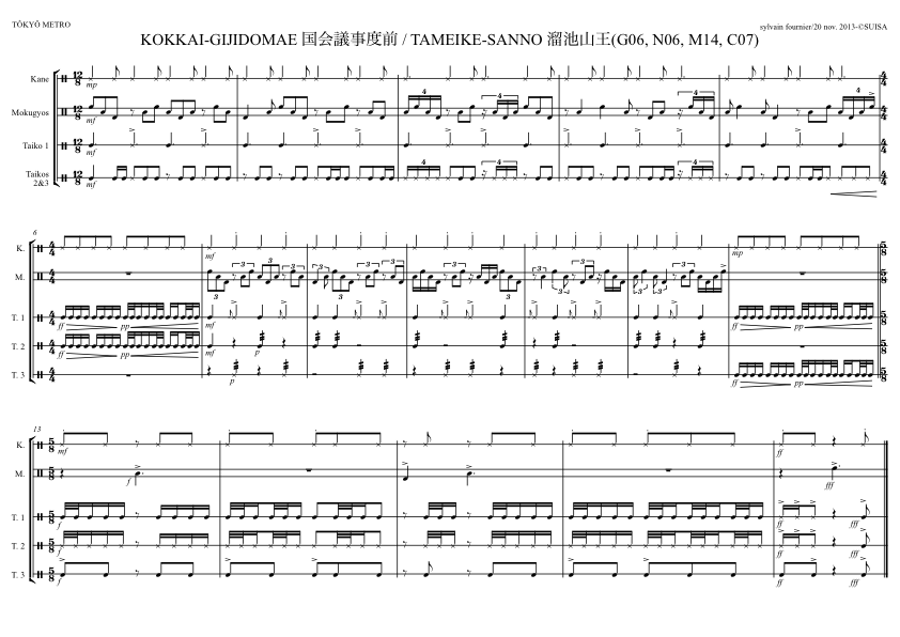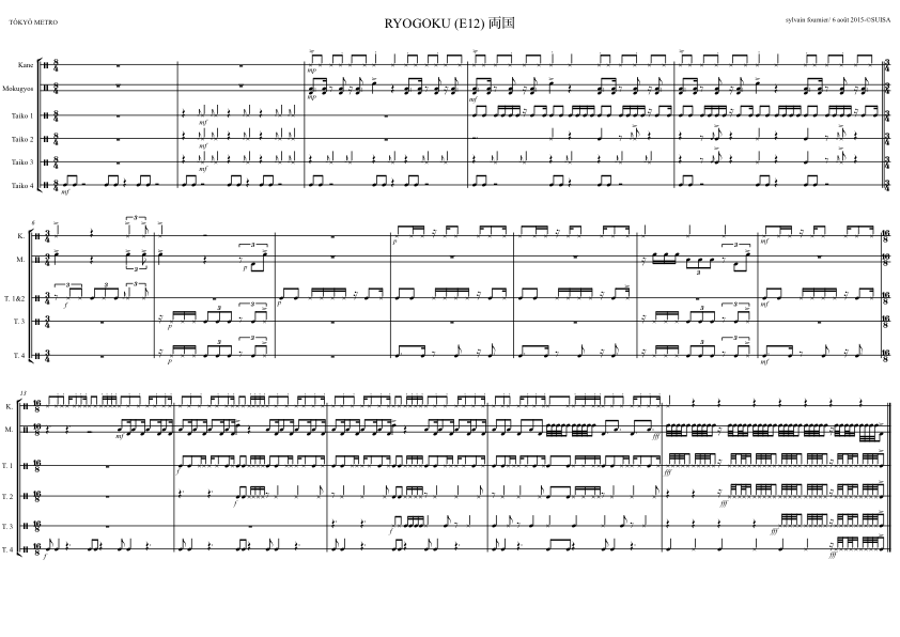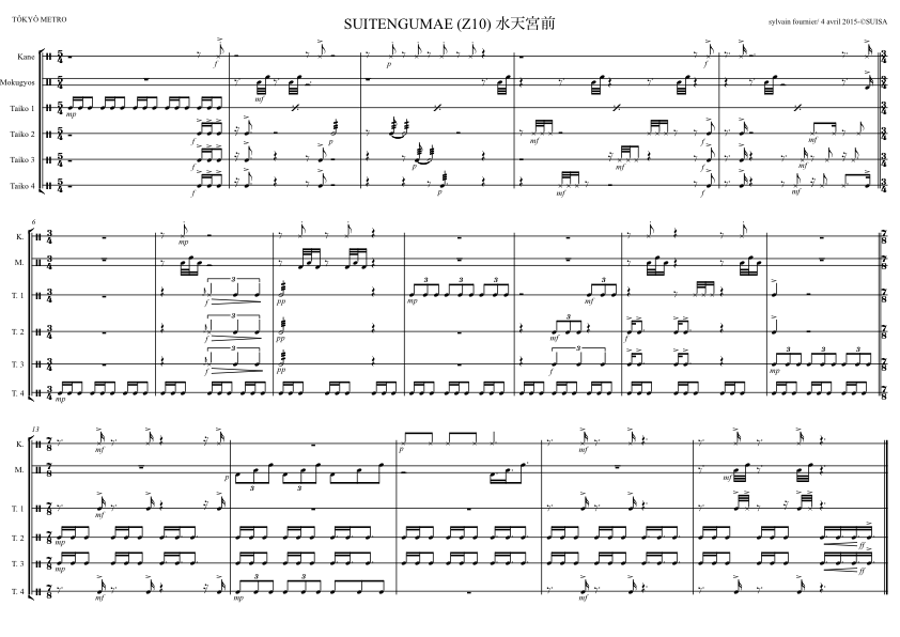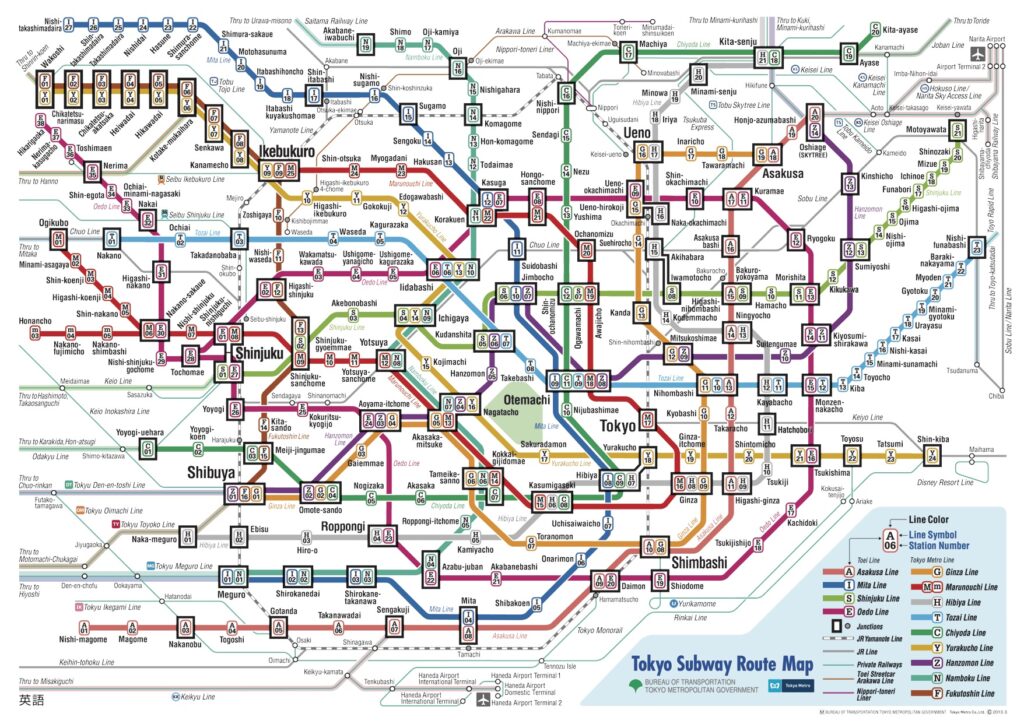COMPOSITIONS POUR PERCUSSIONS
TÔKYÔ METRO
214 courtes compositions pour ensemble de percussions japonaises.
DESCRIPTIF COMPLET CI-DESSOUS (en français et tout en bas: 日本語, english).
L’ensemble des compositions (CONDUCTEUR) papier A4 avec reliure en anneaux métalliques: 40chf/40€ ou en PDF: 30chf/30€.
Payable par virement postal ou passez à la maison.
A COMMANDER ICI
TÔKYÔ METRO est un travail commencé en août 2008 et terminé en septembre 2015. Il s’agit d’un ensemble de compositions correspondant chacune à une des 214 gares du réseau de métro de Tôkyô.
Les contraintes choisies pour ce travail sont que chaque composition
– tienne sur une page
– soit écrite dans le même calibrage de (17) mesures, c’est à dire 5/7/5, celui-ci étant calqué sur le nombre de syllabes des haïkus japonais.
– ait un lien avec la composition voisine, que ce soit dans le type d’écriture (en miroir, polyrythmique, en canon, contrasté, etc.), dans un motif/pattern récurent ou dans la similarité des numérateurs des signatures rythmiques.
A noter que les gares reliées entre elles peuvent être jouées soit isolément soit simultanément, leurs numérateurs de signatures rythmiques étant identiques.
En voici la liste :
« Doubles gares » :
AKASA-MITSUKE/ NAGATACHO
HIBIYA/YURAKUCHO
HIGASHI-NIHOMBASHI/BAKURO-YOKOYAMA
KASUGA/KORAKUEN
KOKKAI-GIJIDOMAE/TAMEIKE-SANNO
Et « Triples gares » :
NAKA-OKACHIMACHI/UENO-HIROKOJI/UENO-OKACHIMACHI
SHIN-OCHANOMIZU/OGAWAMACHI/AWAJICHO
Idéalement, TÔKYÔ METRO est écrit pour un ensemble de percussions japonaises, c’est-à-dire :
–1 KANE : un petit gong aigu à deux notes distinctes (dont le son s’apparente au « tambour de frein » que l’on trouve en percussion occidentale) joué avec une petite baguette dont l’extrémité est fichée d’une sorte de petit marteau très dur.
–3 MOKUGYOS ou blocs chinois (..!) en bois, de trois différentes notes (aléatoires).
–4 TAIKOS (tambours japonais) de grandeurs ou sons différents, le « 1 » étant le plus aigu et le « 4 » le plus grave. Etant donné la grande variété de taikos existant, on choisira les instruments selon leurs disponibilités ou, si possible, selon son goût.




En cas de difficulté pour obtenir des instruments japonais, on peut remplacer ceux-ci par des équivalents : cymbale, granit-blocks, toms, ou autres…
MODE D’EMPLOI
Une particularité de ces compositions réside dans le fait que le tempo n’est jamais indiqué. Ceci à dessein que les exécutants choisissent eux-mêmes les tempi d’interprétation selon leur goût ou leur capacité.
On peut appréhender TÔKYÔ METRO de différentes manières :
1) Idéalement, en choisissant sur la carte un itinéraire entre deux gares et en jouant la suite originale ainsi créée avec les gares intermédiaires.
2) Simplement en choisissant et jouant une ou des gares isolées, selon un thème prédéfini (plutôt pour les interprètes Japonais..!) ou pas.
Il est possible d’agrandir encore le champ des possibilités en alternant les compositions de TÔKYO METRO avec des improvisations par les exécutants ou toutes autres interventions (improvisées ou non) d’autres artistes, musiciens, poètes, danseurs, raconteurs d’histoires concernant les stations choisies, etc.
Bons voyages sous terrains!
(Une carte est disponible tout en bas)
Quelques exemples audios :
KOKKAI-GIJIDOMAE/TAMEIKE-SANNO

RYOGOKU

SUITENGUMAE


東京 メトロ
和打楽器アンサンブルの為の
僕が東京の214のメトロの駅のそれぞれに一つの曲を作曲しようと思い立ち『東京メトロ』の作曲を始めたのは2008年の8月です。それから7年を費やして2015年の9月に遂に完成しました。
『東京メトロ』は214の小品から成り立っています。
作曲にあたって次の事を決めました。
・楽譜は1ページを越えない。
・どの曲も俳句の5,7、5,(17音)の様に先ず5小節で一つの拍子記号を使い、次の7小節はまた別の拍子記号を、最後の5小節でまた拍子記号を変えるという形態にする。
・隣接する駅では何か一つの要素を(拍子、モチーフ、カノン等)分かち合う事にする。
赤坂見附、永田町のように二つの駅がつながれている所ではそれぞれの駅/曲を独自にまたは2曲一緒に演奏する事ができる。
二駅一緒に演奏可能な駅は:
赤坂見附・永田町
日比谷・有楽町
東日本橋・馬喰横山
春日・後楽園
国会議事堂前・溜池山王
酸液一緒に演奏可能な駅は:
仲御徒町・上野広小路・上野御徒町
新御茶ノ水・小川町・淡路町
『東京メトロ』は和打楽器の為に書かれたので、出来る限り和楽器を使用する。
鉦(1)、木魚(3):それぞれ三つ別の音、太鼓(4):4種類の異なる大きさ。太鼓1は高音の物、順々に音の低い太鼓を選ぶ。太鼓は種類が多いので、この選択は奏者の好みに任せる。
演奏方法:
どの曲もテンポの指定が無いので、テンポは演奏者が自由に決める。
メトロの路線図を見てどこの駅からどこを通ってどこ迄行こうと道順を決め、演奏する方法の他、東京を舞台とした自分の物語を駅に託してなぞる、という形の演奏もできる。
その他、別の楽器(即興演奏)、踊り、詩の朗読、駅に関する物語の朗読等の参加も可能。
それでは、素晴らしい東京の地下旅行を!
楽譜(Pdf.)42スイスフラン: 送金はペイパルあるいは銀行振替でお願いします。
TÔKYÔ METRO. For Japanese percussion ensemble
TÔKYÔ METRO is a work started in August 2008 and completed in September 2015. It is a set of compositions, each corresponding to one of the 214 stations in the Tôkyô subway system.
The constraints chosen for this work are that each composition
– Fits on one page
– Is written to the same calibration (17) measures, ie 5/7/5, modelled on the number of syllables in Japanese haikus.
– Has a link with the neighbouring composition, either in the type of writing (mirror, polyrhythmic, canon, contrast, etc.), in recurring pattern or in similarity of the numerators of time signatures.
Note that stations connected together can be played either alone or simultaneously, their numerators of time signatures being identical.
Here is the list of « Double stations »:
AKASA-MITSUKE/ NAGATACHO
HIBIYA/YURAKUCHO
HIGASHI-NIHOMBASHI/BAKURO-YOKOYAMA
KASUGA/KORAKUEN
KOKKAI-GIJIDOMAE/TAMEIKE-SANNO
And « triple stations »:
NAKA-OKACHIMACHI/UENO-HIROKOJI/UENO-OKACHIMACHI
SHIN-OCHANOMIZU/OGAWAMACHI/AWAJICHO
Ideally, TÔKYÔ METRO is written for a group of Japanese percussion instruments, i.e.
–1 KANE: a small gong pitched two separate notes (whose sound is similar to the “brake drum” found in Western percussion) played with a small stick whose end is stuck with a kind of small hard hammer.
–3 MOKUGYOS or Chinese woodblocks (..!), three different notes (random).
–4 TAIKOS (Japanese drums) of various sizes and sounds, the “1” being the higher pitched drum and “4” the lowest. Given the wide variety of existing taikos, the instruments will be chosen according to their availability or, if possible, according to the taste of the players.
In case of difficulty finding Japanese instruments, one can replace them with equivalent: cymbal, granite blocks, toms or any drums…
MANUAL
A feature of these compositions resides in the fact that the tempo is never indicated. The performers themselves choose the interpretation tempi according to their taste or ability.
One can apprehend TÔKYÔ METRO in different ways:
1) Ideally, choosing on the map a route between two stations and playing the original suite created with intermediate stations.
2) Simply by selecting and playing one or isolated stations, according to a predefined theme (rather for interpreters from Japan..!) or not.
It is possible to further expand the range of possibilities in alternating compositions of TÔKYÔ METRO with improvisations by the performers or other interventions (improvised or not) by other artists, musicians, poets, dancers, storytellers about selected stations, etc.
Have a good underground trip!